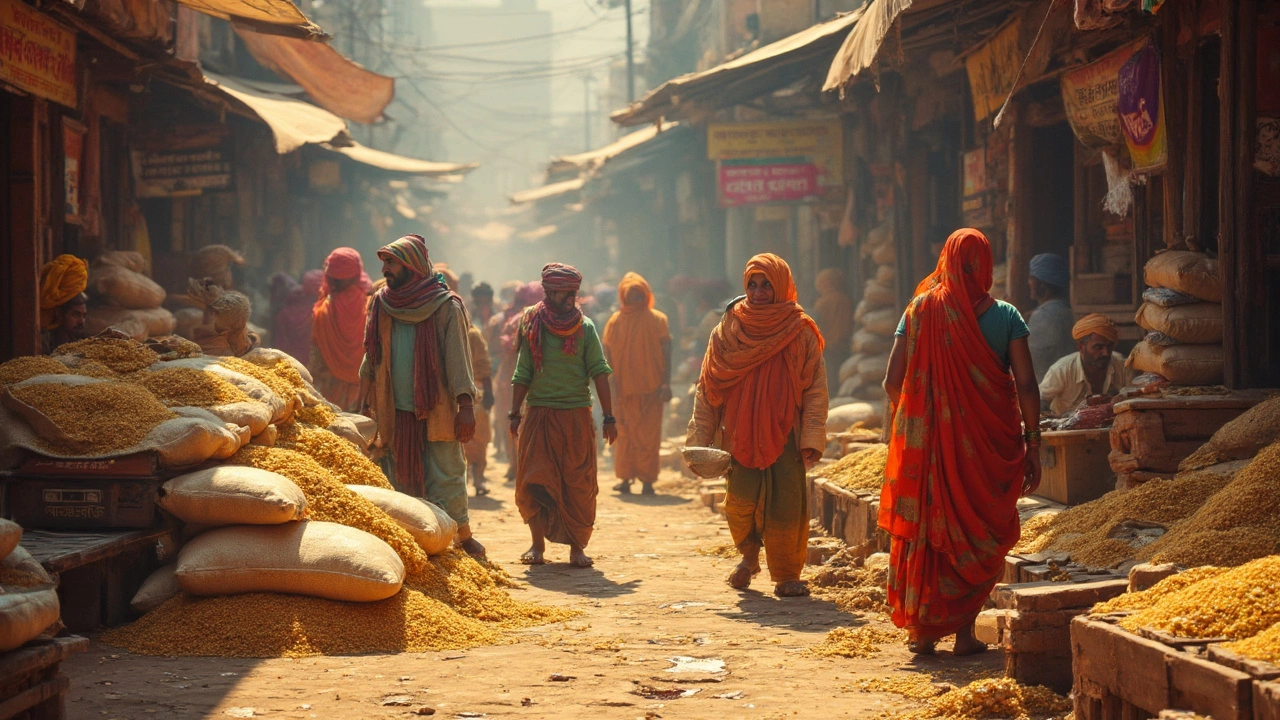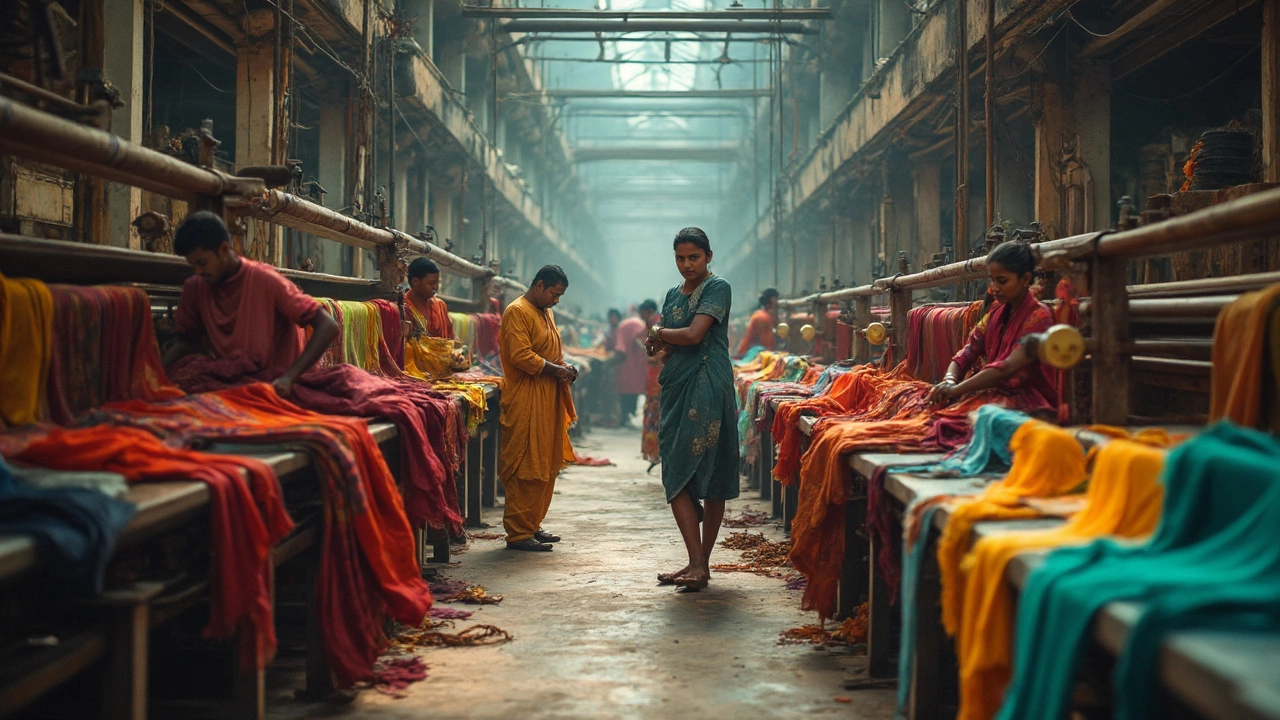
Ever wondered what keeps the Indian economic engine roaring? It’s not just tech parks or call centers. The answer might surprise you: everything from bags of rice to dazzling jewelry and smartphone pills rolls out by the millions. India is like a giant, bustling factory feeding the world, and its most highly produced item says a lot about its history, habits, and hunger for progress. Hold onto your cup of chai, because the numbers behind Indian production will knock your socks off.
Agriculture: The Unbeatable Giant of Indian Production
The heart of Indian production isn’t wrapped in circuit boards—it’s stored in sacks, woven in fields, and spread across millions of hectares. Agriculture is still king here, and rice is the crown jewel. India firmly holds second place worldwide after China when it comes to rice and wheat output. To give you a sense, Indian farmers harvested about 134 million metric tons of rice in 2023—that’s enough to cook biryani for every country on the planet several times over. But that’s just chapter one of India’s food story. The country ranks first in the world for production of pulses (like lentils and chickpeas) and spices, pretty much cornering the global market for the stuff that adds life to curries everywhere.
And yes, sugarcane deserves a mention. India recently overtook Brazil as the world’s biggest producer. The sight of laborers hacking away at thick canes is familiar across Maharashtra and Uttar Pradesh; those two states alone account for the bulk of the sweet harvest that becomes the dessert centerpiece on dinner tables from New Delhi to New York. The numbers get wild – in 2023, India churned out 400 million metric tons of sugarcane, supporting millions of smallholder farmers and an enormous downstream industry.
Here’s the real kicker: Dairy. India’s love affair with milk and ghee is legendary, and it’s not just about tea with extra cream. India has been the largest milk producer globally since 1998, with 223 million metric tons produced in 2023. Imagine herds so large that livestock forms a furry, mooing thread through Indian society itself. Cows, buffaloes, and goats keep the market awash in butter, cheese, and yogurt—making Amul and Mother Dairy as trusted in Indian kitchens as salt and turmeric. These agricultural goods aren't just for local tables; a hefty chunk leaves the country every year, making India a kitchen to the world. If you’re searching for proof, ask a grocer in London where his basmati rice comes from.
| Product | 2023 Production (Million Metric Tons) | Global Ranking |
|---|---|---|
| Rice | 134 | 2nd |
| Wheat | 110 | 2nd |
| Sugarcane | 400 | 1st |
| Milk | 223 | 1st |
| Pulses | 24 | 1st |
If you’re ever shopping for dal (lentils), cumin, or curry powder, odds are high they grew up under the Indian sun. A little known tip for conscious buyers: India’s ‘GI tags’—think of them like food passports—help trace basmati, Darjeeling tea, and Alphonso mangoes to their home turf. Look for those labels for the real-deal taste.
Textiles and Apparel: Threads Spinning Fortune
If you open your closet, there’s a decent chance something inside has its roots in India. The country’s textile history isn’t just ancient—it’s alive, thriving, and roaring down highways from spinning mills to ports. Let’s get specific: India is the world’s second largest producer of textiles and garments after China. Cotton, silk, jute—these fibers are the backbone. In 2023, Indian mills spun up about 6.2 million metric tons of cotton, and the nation leads the globe in jute production, with West Bengal churning out 1.6 million metric tons each year.
The textile sector is a powerhouse for jobs, giving direct employment to over 45 million people and supporting another 100 million through allied activities. Those are mind-boggling numbers, and it’s hard to find another industry that weaves so many livelihoods together. Walk down the streets of Ludhiana or Tiruppur, and you’ll see busy workers crafting everything from denim jeans and knitwear to sarees decked in gold thread. Some of the world’s biggest brands source from here—Gap, H&M, Zara, and Uniqlo, to name a few.
And don’t even get me started on handlooms. India’s handloom sector is legendary, a living heritage run almost entirely by cottage artisans, mostly women. Each region has its signature style: think Banarasi silk from Varanasi, Kanchipuram silk sarees from Tamil Nadu, or Pashmina from Kashmir. Over 67,000 cotton weaving clusters dot the landscape, making the industry one of most decentralized anywhere on earth. Here’s a cool fact: when Emily and I travel, she insists on picking up local fabrics—she once spent hours in Jaipur bargaining for block-printed bedsheets, and let’s just say, the suitcase barely zipped.
If you’re hunting for value, Indian textiles offer a sweet spot. Indian cotton goods, whether it’s bed linens or basic T-shirts, combine price with surprising quality—one reason why export figures crossed $45 billion in 2023. If you care about sustainability, the growing organic cotton movement in India is worth watching. Big tip: when shopping, look for clothing marked with the ‘Handloom Mark’ or ‘India Handloom Brand’—it means an actual artisan crafted it, not a robot.

Steel, Automobiles, and Pharmaceuticals: Heavyweights of Indian Industry
Let’s shift gears from fields and fabric to factories. India isn’t just about what you eat or wear; it’s rising as a global heavyweight in steel, vehicles, and pharmaceuticals. The steel story is epic—India has been the world’s second largest steel producer since 2018, pushing out a record 130 million metric tons in 2023. Companies like Tata Steel and JSW churn out everything from skyscraper girders to razor-thin sheets for new-age cars.
The automobile sector is equally turbocharged. India became the world’s third largest passenger vehicle market in 2023, overtaking Japan (yes, really!). Brands like Maruti Suzuki, Tata Motors, and Mahindra roll hundreds of thousands of cars, bikes, and trucks off the assembly line every month. Two-wheelers are a national obsession—over 20 million motorbikes are produced here each year, making India the top producer globally. That explains why cities like Bengaluru and Pune are packed with scooters and rickshaws weaving through traffic like it’s a video game come to life.
And then there’s pharma. Long known as ‘the pharmacy of the world’, India mass-produces generic drugs for countries across every continent. Indian companies make more than 60% of global vaccine supply and are top suppliers of active pharmaceutical ingredients (APIs)—the stuff that powers your painkillers and antibiotics. The numbers: in 2023, pharma exports hit $27 billion, and every second child’s vaccine in the world likely came from Pune or Hyderabad. It’s not just big brands; dozens of mid-sized firms are scaling up, with intense R&D in cancer, diabetes, and infectious diseases.
Here’s a fun behind-the-scenes detail: Indian pharma soared after a 1970s patent law opened the floodgates for generic manufacturing, allowing homegrown scientists to experiment and innovate on a global scale. This has made medicines affordable in Africa, Latin America, and outer corners you’d never imagine. And yes, even many brands you see in Western pharmacies use Indian-made ingredients. If you’re on the lookout for affordable and reliable meds, Indian generics are often the secret source. Quality tip: stick to major brands and check for World Health Organization (WHO) certifications if buying internationally.
| Product | 2023 Production (Million Metric Tons/Units) | Global Rank |
|---|---|---|
| Steel | 130 | 2nd |
| Automobiles (Units) | 29.4 | 3rd |
| Pharmaceutical Exports (USD Billion) | 27 | 1st (Generic drugs) |
Indian heavy industry is investing deep in green technology, so watch this space—the next big thing might just roll out of a Mumbai or Chennai factory. For now, though, if you ever find yourself traveling on an Asian highway, chances are you’ll spot vehicles, machinery, or even railways stamped ‘Made in India’.
Jewelry, IT, and Surging Newcomers in Indian Production
Sure, people talk about India’s wheat and wheels, but there’s a dazzling, high-glam side too: jewelry. India processes and polishes about 90% of the world’s diamonds—yep, those little bits of stardust probably passed through hands in Surat or Mumbai before landing on a finger in Paris or New York. Gold jewelry production is a national art form; Indians buy nearly 700 tons of gold each year, much of it recycled and refashioned into bangles meant for weddings and festivals. That’s more personal bling per capita than almost anywhere else.
The software boom isn’t just about code and coffee, either. Indian IT and software services now rake in over $250 billion a year. Companies like TCS, Infosys, and Wipro aren’t making physical products but are exporting virtual know-how—the funny part is that even the biggest US and European banks rely on teams in Bengaluru or Hyderabad to keep their systems humming. The digital products made here range from banking software and mobile apps to AI-powered services, and these exports are only getting bigger every year. As economies lean harder on digital solutions, India’s share of the pie is growing fast.
Other industries firing up? Think chemicals, processed foods, cement, and electronics. India has become a world leader in smartphone assembly—about 200 million devices were made here in 2023, thanks in part to new factories from Samsung, Xiaomi, and Apple. Even Apple’s iPhones now proudly carry ‘Assembled in India’ on some models. Electronics exports are now north of $12 billion and ticking upward.
- Products produced in India contribute directly to millions of domestic jobs and global supply chains.
- India’s diversity means no single product dominates—strength comes from a mix of legacy (like agriculture and textiles) and tomorrow’s tech stars (like electronics and software).
- If you travel to India, visiting local markets is a crash course in what’s being made—talk to sellers for tips on quality and how to spot genuine versus imitation goods.
- Popular Indian brands to look for? Tata, Godrej, Amul, FabIndia, Bajaj, and Sun Pharma are local giants making waves globally.
Indian manufacturing is morphing fast, thanks to a rising skilled workforce, government ‘Make in India’ campaigns, and the world’s biggest youth population. Whether it’s a sack of rice, a block-patterned quilt, a box of life-saving drugs, or the phone in your pocket, India’s production covers more ground every year. Next time you check where something’s made, don’t be shocked if it’s stamped from the subcontinent—the stats aren’t lying: India is one of the planet’s busiest makers, with culture, industry, and innovation all bundled up and ready to ship.